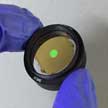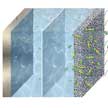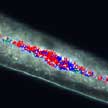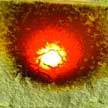Showing Spotlights 401 - 408 of 2784 in category All (newest first):
 Researchers have developed a high-throughput, scalable nanocomposite printing method to manufacture metalenses at low cost, paving the way to commercializing them. The nanocomposite material, which is also suitable for high-efficiency metasurfaces, can be molded into metalenses just by one step of printing without any secondary operations such as thin-film deposition or plasma etching. The researchers synthesized their nanocomposite by dispersing silicon nanoparticles in the matrix of UV-curable resin to achieve a high-refractive index to increase the efficiency of the metalenses. The printing mold is reusable, so the large-scale metalenses can be printed rapidly and repeatedly.
Researchers have developed a high-throughput, scalable nanocomposite printing method to manufacture metalenses at low cost, paving the way to commercializing them. The nanocomposite material, which is also suitable for high-efficiency metasurfaces, can be molded into metalenses just by one step of printing without any secondary operations such as thin-film deposition or plasma etching. The researchers synthesized their nanocomposite by dispersing silicon nanoparticles in the matrix of UV-curable resin to achieve a high-refractive index to increase the efficiency of the metalenses. The printing mold is reusable, so the large-scale metalenses can be printed rapidly and repeatedly.
Jan 12th, 2021
 In the search for battery technologies that one day could replace lithium-ion batteries and meet power demands within the size and cost constraints of car makers, aerospace and other industries, researchers are exploring lithium-air batteries (LAB). Generally, to make LAB technology practical, two goals are highly important: a novel cathode that uses a highly active and stable catalysts to enhance ORR and OER kinetics; and a proper electrolyte design that can promote the solvent-based growth mechanism for the discharge products.
In the search for battery technologies that one day could replace lithium-ion batteries and meet power demands within the size and cost constraints of car makers, aerospace and other industries, researchers are exploring lithium-air batteries (LAB). Generally, to make LAB technology practical, two goals are highly important: a novel cathode that uses a highly active and stable catalysts to enhance ORR and OER kinetics; and a proper electrolyte design that can promote the solvent-based growth mechanism for the discharge products.
Dec 29th, 2020
 An overview of feedback-driven, skin-like multifunctional sensor systems, from the basic material/structural design to applications. Emerging functional nanomaterials and innovative structures for constructing flexible sensors are highlighted, followed by an introduction of various integrated flexible sensor systems. Several categories of feedback sensor systems are described in terms of prosthesis- and AR/VR-based human-machine interfaces, smartphone-based approaches for point-of-care detection, and smart wearable displays for direct signal visualization. The profound significance of these innovations is also highlighted.
An overview of feedback-driven, skin-like multifunctional sensor systems, from the basic material/structural design to applications. Emerging functional nanomaterials and innovative structures for constructing flexible sensors are highlighted, followed by an introduction of various integrated flexible sensor systems. Several categories of feedback sensor systems are described in terms of prosthesis- and AR/VR-based human-machine interfaces, smartphone-based approaches for point-of-care detection, and smart wearable displays for direct signal visualization. The profound significance of these innovations is also highlighted.
Dec 28th, 2020
 While plastic debris of any size is harmful to the marine flora and fauna, recent research suggests that the smallest of these plastics, nanoplastics, affect the composition and diversity of our intestinal microbiome and that this can cause damage to our health. A novel optical spectroscopy-based methodology in the VIS-NIR range, capable for differentiating between chemically different micro- and nanoplastics confined within invertebrate intestines. The technology is based on dark-field microscopy, which is capable of visualizing particles smaller than the bright-field optical microscopy resolution limit.
While plastic debris of any size is harmful to the marine flora and fauna, recent research suggests that the smallest of these plastics, nanoplastics, affect the composition and diversity of our intestinal microbiome and that this can cause damage to our health. A novel optical spectroscopy-based methodology in the VIS-NIR range, capable for differentiating between chemically different micro- and nanoplastics confined within invertebrate intestines. The technology is based on dark-field microscopy, which is capable of visualizing particles smaller than the bright-field optical microscopy resolution limit.
Dec 22nd, 2020
 Back in the spring of 2015, one of our Nanowerk Spotlights asked the question: 'Has nanomedicine lived up to its promise?' The answer then was that, judging by research activity and funding, the field of nanomedicine has been very fertile; however, by using the yardstick of clinical success and paradigm shifts in treatment, the results appear quite a bit more modest. So here we are, at the end of 2020, and the answer to that same question still is inconclusive. To address this problem, researchers now propose the creation of new nanomedicine design criteria.
Back in the spring of 2015, one of our Nanowerk Spotlights asked the question: 'Has nanomedicine lived up to its promise?' The answer then was that, judging by research activity and funding, the field of nanomedicine has been very fertile; however, by using the yardstick of clinical success and paradigm shifts in treatment, the results appear quite a bit more modest. So here we are, at the end of 2020, and the answer to that same question still is inconclusive. To address this problem, researchers now propose the creation of new nanomedicine design criteria.
Dec 14th, 2020
 Virtual reality (VR) and augmented reality (AR) are some of the hottest multidisciplinary technology trends right now, integrating computer, various sensor, graphic image, communication, measurement and control multimedia, artificial intelligence, and other technologies. Interactive electronic textiles will provide suitable platforms for VR/AR applications to provide a full range of sensory perceptions. Intrinsic conductive nanomaterials such as carbon nanotubes and metallic nanowires as well as nanoscale devices such as triboelectric nanogenerators are key to developing these electronic textiles.
Virtual reality (VR) and augmented reality (AR) are some of the hottest multidisciplinary technology trends right now, integrating computer, various sensor, graphic image, communication, measurement and control multimedia, artificial intelligence, and other technologies. Interactive electronic textiles will provide suitable platforms for VR/AR applications to provide a full range of sensory perceptions. Intrinsic conductive nanomaterials such as carbon nanotubes and metallic nanowires as well as nanoscale devices such as triboelectric nanogenerators are key to developing these electronic textiles.
Dec 7th, 2020
 Wearable thermal insulation materials for harsh environments always require a compromise during their design and manufacturing. On one hand they need to be mechanically tough to provide impact resistance. On the other hand they need to be heat resistant. Now, researchers have developed a wearable aramid/ceramic aerogel nanocomposite material with both excellent mechanical and thermal properties. The key to this fabrication method is the in situ crosslinking that takes place between the silica pre-ceramic aerogel precursor and the Kevlar fibers.
Wearable thermal insulation materials for harsh environments always require a compromise during their design and manufacturing. On one hand they need to be mechanically tough to provide impact resistance. On the other hand they need to be heat resistant. Now, researchers have developed a wearable aramid/ceramic aerogel nanocomposite material with both excellent mechanical and thermal properties. The key to this fabrication method is the in situ crosslinking that takes place between the silica pre-ceramic aerogel precursor and the Kevlar fibers.
Nov 30th, 2020
 One of the issues with microfluidic devices in life sciences is that most platforms rely on materials or chemicals that are outside the biological breadth as building blocks, scaffolds, or coatings for the devices. In a game-changing approach, researchers are developing a transformative way to fabricate microfluidic devices, where solid walls are replaced by transparent, morphing fluid walls using only biocompatible materials. This novel method can generate cell-friendly microfluidic devices on demand with features below 50 microns in size.
One of the issues with microfluidic devices in life sciences is that most platforms rely on materials or chemicals that are outside the biological breadth as building blocks, scaffolds, or coatings for the devices. In a game-changing approach, researchers are developing a transformative way to fabricate microfluidic devices, where solid walls are replaced by transparent, morphing fluid walls using only biocompatible materials. This novel method can generate cell-friendly microfluidic devices on demand with features below 50 microns in size.
Nov 19th, 2020
 Researchers have developed a high-throughput, scalable nanocomposite printing method to manufacture metalenses at low cost, paving the way to commercializing them. The nanocomposite material, which is also suitable for high-efficiency metasurfaces, can be molded into metalenses just by one step of printing without any secondary operations such as thin-film deposition or plasma etching. The researchers synthesized their nanocomposite by dispersing silicon nanoparticles in the matrix of UV-curable resin to achieve a high-refractive index to increase the efficiency of the metalenses. The printing mold is reusable, so the large-scale metalenses can be printed rapidly and repeatedly.
Researchers have developed a high-throughput, scalable nanocomposite printing method to manufacture metalenses at low cost, paving the way to commercializing them. The nanocomposite material, which is also suitable for high-efficiency metasurfaces, can be molded into metalenses just by one step of printing without any secondary operations such as thin-film deposition or plasma etching. The researchers synthesized their nanocomposite by dispersing silicon nanoparticles in the matrix of UV-curable resin to achieve a high-refractive index to increase the efficiency of the metalenses. The printing mold is reusable, so the large-scale metalenses can be printed rapidly and repeatedly.
 Subscribe to our Nanotechnology Spotlight feed
Subscribe to our Nanotechnology Spotlight feed





